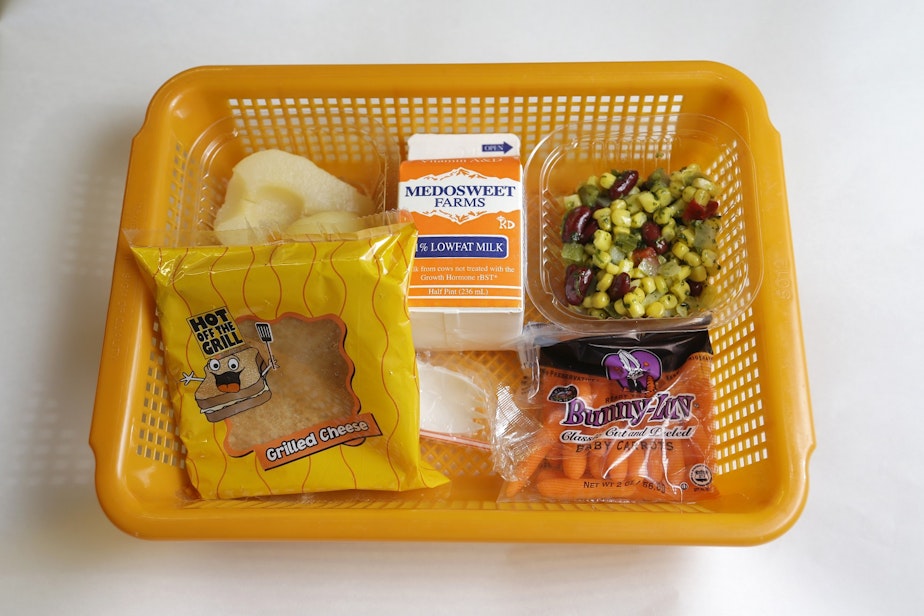Ravioli in a warm fridge ... and other violations at Seattle school cafeterias

Ravioli sitting in a malfunctioning refrigerator …
Workers without proper training or food-handling permits ...
A kitchen sink that shut off after five seconds …
These are some of the violations King County health inspectors found when they toured public school kitchens in Seattle.
School cafeterias are known among health inspectors for being clean — but not in Seattle. Here, 11 cafeterias, serving 12 schools, had “unsatisfactory” ratings on their latest inspections due to one or more "red critical" violations, like food at unsafe holding temperatures, faulty hand-washing stations and workers lacking the proper training or food-handling permits.
Eyob Mazengia, who oversees such inspections for the health department, pulled up the details of an infraction an inspector noted this year at a Seattle elementary school.
Sponsored
"It says, ‘Do not serve pizza and ravioli that have been in walk-in since at least yesterday,’” Mazengia said.
Day-old pizza and ravioli are theoretically healthy, Mazengia said, but not if they’re stored in a warm refrigerator. At this elementary school, part of the walk-in cooler was 50 degrees, "and maximum temperature allowed in a cold-holding unit is 41," he said. That cafeteria got an “unsatisfactory” rating.
KUOW found that some school cafeterias have had repeated health code violations for years.
West Seattle Elementary School has had violations on seven of its last ten cafeteria inspections.
Lowell Elementary School has had violations on nine out of ten inspections.
Sponsored
In Seattle, as in many districts, a central kitchen now prepares most of the food served at schools, much of which is reheated in cafeteria kitchens. The central kitchen is also inspected, and it, too, had violations on half of its last 10 inspections, including inadequate hand-washing stations and unsanitary food contact surfaces.
Seattle Public Schools turned down requests for an interview for this story, but said in a written statement: "We continue to be confident in our processes that rigorously follow health department guidelines and enable us to provide safe, nutritious food for our students...
"In this case, presenting anyone with simply large numbers about SPS health code violations could be misleading unless the data was also accompanied by detailed facts. Those detailed facts would show that, taken on the whole, the infractions identified by the health department are, for the most part, routine infractions that any food service establishment experiences; the infractions at SPS occur at a pace that is common to all food service establishments; and the infractions at SPS are always promptly corrected."
Low-income kids, who eat three-quarters of the meals served in Seattle Public Schools, would be the most likely children affected by foodborne illness. Reduced-price or free school meals are, for some children, their only reliable daily source of nutrition.
In 2016, an outside study the district commissioned of its Nutrition Services operations identified the food temperature control problems that often lead to "unsatisfactory" ratings.
Sponsored
"The district lacks equipment and supplies to maintain temperatures on the serving line. Staff has difficulty keeping hot foods hot and cold foods cold throughout the serving period," researchers found upon visiting Seattle school cafeterias.
"In several cases, it appeared that food safety might be in question."
Leanne Eko, who directs who directs Child Nutrition Services at the state schools office said most schools get great scores.
"There’s always a standing joke about how it’s the cleanest and the safest place to eat in a community," she said.
In the Highline School District, just south of Seattle, there were no recent “critical” food safety violations at its cafeterias listed on the Public Health - Seattle & King County website.
Sponsored
Eko said Seattle's track record is different from the squeaky-clean cafeteria kitchens she's familiar with at other districts in the state.
"I’m surprised by what you shared about what you found in the Seattle area," she said. "It’s a little disturbing to hear that."
By federal mandate, county health departments across the state examine school kitchens twice annually to make sure they’re up to code.
There have been foodborne illnesses traced to Washington colleges and universities in recent years, according to CDC data, including salmonella, E. coli, and norovirus, but none linked to local K-12 cafeterias.
Eko said an outbreak could be serious, however, "because with any kind of foodborne illness, we know that it has a larger effect on young kids."
Sponsored
In the long-run, King County is expected to require schools to display the same “smiley-face” signs as restaurants, but Mazengia said there’s no timeline yet. Until then, University of Washington food safety lecturer Charles Easterberg said families should do their own research, starting with pulling up inspection reports on their county health department website.
If they see health code violations, he said, “they can go to the school and ask for elaboration, and they can also call the health department and they can ask for them to interpret. Then the last thing they do is say, 'Okay, what has been done about it, and what’s going to be done about it?'"




